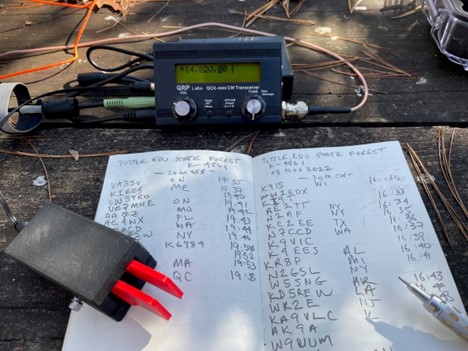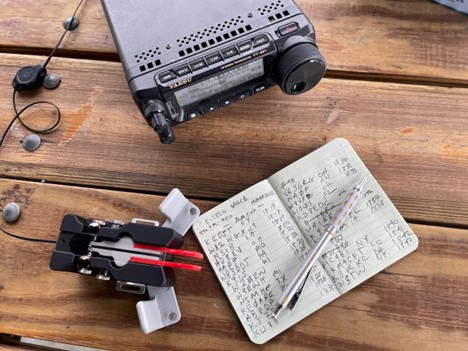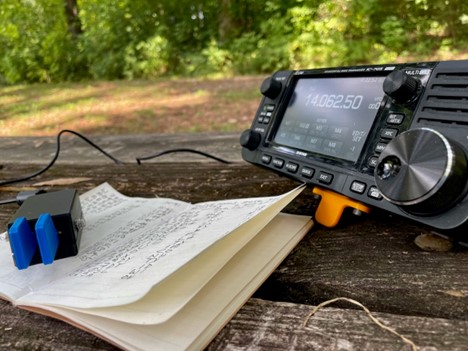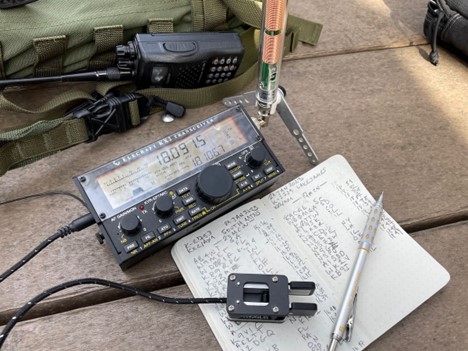I recently received a question from Richard, who asked:
“Is it rude to always [add] a ‘?’ with a partial call? And how do you do partials with everyone jumping in after a contact?”
A great question, Richard. Let me try to share my thoughts about this with you.
First of all—and let’s get this out of the way up front—I feel it’s never rude to use a “?” or send “AGN?” to dig a partial call out of a CW (Morse code) pileup or out of the noise. No more so than telling a speaker in the course of ordinary conversation, “I’m so sorry; I didn’t get that. You were saying…?” Since that isn’t practical in CW, a simple “?” does the job effectively and succinctly.
The “?” is a communication tool pretty much all CW activators use routinely. I do so multiple times in almost every single activation I perform these days, especially since Parks On The Air has become such a popular activity and pileups have become common.

In my opinion, judging whether something is good CW “etiquette” is simply a matter of imagining you’re the other op. Ask yourself, “What’s their goal?” If you were in their shoes, you’d realize their goal is communication. They want to get their call across to you and are usually quite willing to be patient enough to do just that. After all, they hopped into the pileup knowing that it might take time to reach you. So, to be asked to repeat just means their effort is paying off!
For the same reason, it’s also never rude to send “QRS” (please slow down) when the op on the other end is sending code a little too speedily. Most operators are more than happy to oblige. We have to consider that everybody has their own pace of sending as well as receiving, including the new-to-CW learners out there.
Digging Out Partial Calls
Over time, I’ve developed my own technique for working with partial calls, and I’m sure it’s similar to what others do. You, too, will find your own natural cadence and technique.
You can be assured that you’ll need to work partial calls in at least the following situations:
- During heavy pileups (numerous stations trying to contact you at the same time)
- When the bands are noisy (QRN)
- When you have manmade interference (QRM)
- When fading is prevalent (QSB) or the band is unstable
- When working faint signals from DX or QRP operators
To better describe how I manage partial calls, here are a few sample scenarios—for these examples, I’ll borrow my longtime Elmer Eric’s callsign, WD8RIF (thanks, Eric!).

Scenario 1: Partial in a Heavy Pileup
Let’s say I’m activating a particularly desirable summit on a weekend with excellent propagation. Pileups in this situation can be very heavy…almost DXpedition-like! This might sound scary to a new activator, but trust me, you can get through this. It’s all about whittling down the pileup so you can hear just one callsign. And if you’re like me, you might even enjoy the challenge!
Keep in mind that, as the activator, you are the one in charge of the pileup and who you call.
Let’s say in a huge pileup all I hear is the letter “R.” I would simply send “R?” Or, there’s quite a big group coming back to me and let’s assume they all have “R” in their calls. I do hear “8R” in there at about the same tone level that I heard the original “R” call in. I would then send “8R?“
This should effectively open the door to that one ham radio operator because the chances of multiple people having an “8R” combination in their call is much lower.
Hopefully, you’ll now be able to catch the full call, “WD8RIF” and will be able to reply with a complete exchange.
This scenario took a total of two callbacks: first with “R,” then with “8R.” This is actually quite reasonable in a noisy and unruly pileup situation. There have been times I have needed four or more callbacks to finally snag a full call. And that’s fine—the main thing is that I got it!
Scenario 2: Close Call…
In this scenario, let’s say I’m managing a large pileup after calling “CQ POTA,” but I very clearly hear a “WD8” in the pile of calls. I would then send, “WD8?”
Let’s further assume that three stations come back to me, all on top of each other so it’s difficult to distinguish the callsigns, but one partialcall—WA9—is very loud and clear. It might be tempting to send “WA9” and simply abandon the “WD8” call, knowing that it would be so easy to work the WA9 station and then just call back later for WD8 after working WA9.
Tempting as it is, this is not how I would handle the situation, and I wouldn’t recommend it for reasons I’ll explain in a moment. Rather, I would stick with calling back “WD8” until I could copy the full call. If, however, after sending “WD8” three times in succession, I still hear no one coming back, then I would send something like, “SRI QRZ K4SWL POTA” to effectively restart the pileup.
So why would I forfeit an easy, strong call like the WA9 station?
Many of the folks chasing your station in the pileup will notice if you call for a specific partial and then come back to someone completely different. This alerts the pileup that if they want to bust through, they should do the same: simply wait for you to request a partial call, then send their call anyway so they have less competition to be heard.
As the activator, I am in charge of the pileup and I set the example for others. So if I answer people I do not call (partial or not), it only encourages (some) others to ignore my partial requests, which makes it even more difficult to dig a partial call out of a pileup! It leads to a chaotic free-for-all that doesn’t reward those who play by the rules. It discourages your initial caller, as well as making the situation slower and more difficult for you and everyone else.
To be clear, just because the WA9 station came back doesn’t mean they’re trying to be rude. Quite often, they may have thoughtyou sent “WA9?” due to, for example, poor band conditions. If they hear me come back persistently with “WD8?” they’ll soon realize I only want that station and will usually be fine with waiting their turn.

Scenario 3: Missing in the Middle
This time, let’s assume that band conditions are very unstable due to incoming CMEs, X-Class Flares, or other drama from our local star. At times like this, fading (QSB) can be deep; it can take an S7 signal to S2 or S-zero within seconds.
Then, let’s say that after calling “CQ POTA de K4SWL” for a few minutes, I hear a very faint “RI” in static. I would then send back “RI?”
I listen very carefully and hear a “W” and “IF.” Logically, I could probably sort out that the call ends with RIF since in the U.S., normal call suffixes are only one, two, or three letters. Since W is a common prefix in the U.S. (like K, N, A, etc.), I might assume that the call is either W_RIF or W_ _RIF.
While there’s no rule against it, I would never send something like “W?RIF” with the “?” in the middle of the call. It’s not common practice in CW, so the station calling me would likely not expect that reply. It would only lead to confusion.
Instead, I would choose to send “W?,” “RI?” or “RIF?” Personally, I would likely go with the most complete option, which is “RIF?” Going with a “W?” could open the door to a number of activators with a W prefix. Again, your goal is to rapidly narrow down the selection, not expand it.
After hearing “RIF?” being called, an experienced chaser would then send their reply call at least two times in a row so that you could eventually reply with the complete call of “WD8RIF.”

A Tip for Hunters
A quick note for hunters/chasers: If an activator comes back to you with a partial call, resist the urge to only send back the missing part of the call; this leads to confusion on the activator’s side. I had this happen very recently during an activation.
For example, if your call is WD8RIF and the activator requests “WD8?,” don’t reply with only “RIF.” Unless, of course, you and the activator know each other quite well, in which case they’ll instantly know your full call when they hear your suffix.
Keep in mind that on the activator’s side, they’re trying to piece together a full callsign with what they have. When you send only your suffix, the activator is going to question whether your prefix is “WD8” and likely only repeat “WD8?”
But when you reply with your full call, “WD8RIF,” preferably a little more slowly and twice in succession, it allows the activator to confirm that, yes, this is the WD8 call and their suffix is definitely RIF. It’s simply more clear and accurate that way.
Summary
To reiterate what I said at the beginning of this article, don’t ever hesitate to work partial calls and send question marks if needed.
I know that as a new CW operator, you might feel like sending loads of question marks and partial call requests might make you appear to be a beginner. Don’t worry about that! Everyone has been there, and thank goodness for that or else we’d never have anyone out there to call. Plus, you’ll find as a park and summit activator that partial call requests—especially due to pileups—are the rule, not the exception.
Trust me, you’ll find your own effective pattern for working partial calls, and it’ll become second nature. Take a breath, trust your ears, and soon you’ll have it down. And I assure you, if you’re new to the game, most activators remember when they were new, too, and will be happy to help you get up to speed.
Feel free to share your tactics for working partial calls in the comments section of this post.

